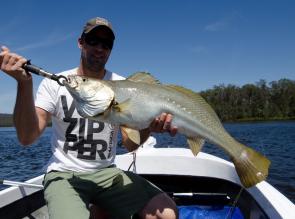Another year has flown by and the festive season is upon us once again. For many people this means loading up the family car and hitting the road for the annual holiday.
Getting on or in the water is always a high priority for the visitor and despite the obvious crowds this is still a fantastic time of year to be chasing a few fish.
The local estuary scene is fishing fantastic thanks to some decent Spring rains flushing the systems after a very dry Winter.
I have been regularly scoring well on 45cm-55cm flathead, the perfect sized fish to keep for a feed. Any thing above 60cm I prefer to release because they are basically all breeding females and are best left to keep populating our rivers and lakes.
Yellowfin bream numbers in the lower system should now be plentiful after a pretty slow start to the season. A good spread of fish can be found around the oyster racks, shallow weed beds and various rock bars.
For me Summer bream fishing means only one thing – targeting them with surface lures in the shallows. The excitement of teasing, hooking and hopefully extracting a kilogram-plus of angry bream from its unforgiving, oyster-encrusted home is hands down the best way to catch one.
If they are schooling tight and actively feeding, it won’t take much skill to get them to bite but if they are spread out and timid then it will require stealth and finesse to get a reaction. In this situation long pauses and subtle twitches are what can turn a looker into a taker.
The upper reaches have been good for black bream around fallen timber and surface lures work equally well on them.
The upper reaches have been holding masses of tiny baitfish often referred to as ‘eyes’, so a small translucent soft plastic minnow or a tiny shallow diver could be worth a try.
In the Clyde River the shallow weed flats around Little Island have been absolutely crawling with blackfish of all sizes. Not too many anglers seem to target blackfish in the Clyde so if you are into chasing them there is definitely no shortage of opportunities.
Some big whiting have also been cruising the flats but the numbers have been fairly scattered. Once they begin to school up and begin their breeding aggregations they will be viable surface targets.
I find them impossible to tempt when they are not around in numbers but when concentrated in an area they become dead easy to catch as they shoulder each other out of the way to be the first to smack a lure.
Jewfish should be around with the possibility of a fish well over 20kg, particularly around the bridges at night. By day there has been the odd 70cm-90cm school fish.
Prior to the Spring rains bass numbers in the fresh were very sparse but the solid downpours allowed them to sneak over the crossing into the fresh later than normal. From eyewitness accounts dozens, if not hundreds, of fish were seen flapping their way over the causeway on their sides with less than 10cm of water on their way upstream.
Ross Noakes scored a nice bass in the high 40cm range from the bank but the bulk of captures so far have been more like 30cm. With the first few waves of cicadas emerging from the ground I expect to hear of plenty of bigger fish belting lures.
The first of the true warm currents will start to spiral down to the South Coast this month. The albacore of the past few months will thin out and make way for the first wave of striped marlin and hammerhead sharks, closely followed by black marlin.
There is always a chance of stray yellowfin tuna crashing a lure spread but after a really ordinary Winter I wouldn’t expect to see too many.
With the supposed shift from La Niña to El Niño this year, let’s hope we get a good showing of mahi mahi to make up for last year’s fiasco. Not once did we see a single fish last year at the FADs or around any piece of flotsam.
Some of the fish real estate we came across was too good to be true– big trees covered in gooseneck barnacles, planks of wood, stray floats with weed-covered rope – and all that they housed were leatherjackets or 30cm kingfish.
Speaking of kingfish, the signs are looking good for a better season with regular reports of 60cm-90cm fish coming from the reefs and islands off Durras and wide of Moruya.
Anglers fishing bottom baits in deep water report good catches of ocean perch, indicating this species has had a bit of a recovery since the removal of the trawl fishery from the marine park.
Snapper to 5kg as well as big morwong and flathead are also keeping the bottom-bouncing brigade happy.
Reads: 1938
Fisheries research officer Dylan Van Der Meulen with a flathead approaching 80cm prior to release.

Jewfish like this 70cm specimen have been fairly common in the Clyde River and have been showing up from the mouth right up to the brackish zones. This one ate a 100mm Slick Rig.




